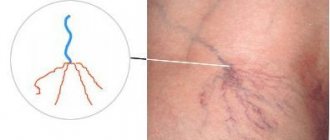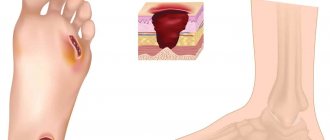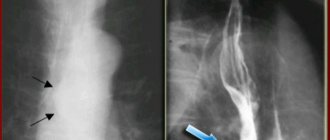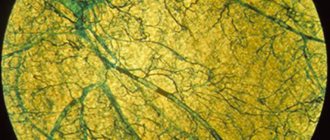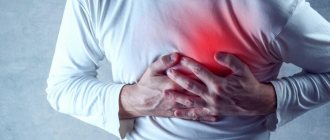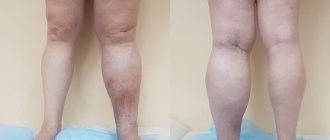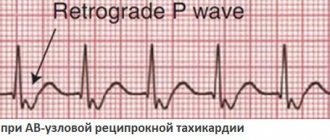SVC syndrome is a congenital anomaly of the development of cardiac structures, in which an extra conductive bundle is formed in the heart, transporting an electrical impulse from the sinus node to the ventricles, bypassing the atrioventricular node, which leads to premature excitation of the ventricles.
By its nature, this is a vice, but it is not immediately revealed. Symptoms in the early stages are minimal. As a rule, the detection of such a phenomenon is an accident detected during electrocardiography. The signs are quite characteristic, so it is almost impossible to confuse the condition.
The disease is also called Wolff-Parkinson-White syndrome, named after the most prominent researchers.
Treatment of the condition has certain prospects at any stage. They are best at the time of detection, when there are no organic defects yet.
The mechanism of pathology development
The essence of the deviation is the formation of an extra pathway in the heart.
This is the normal state of affairs. Cardiac structures have the ability to contract and work autonomously due to the presence of a cluster of active cells that generate an electrical impulse.
This is the so-called sinus node or natural pacemaker. He works constantly. The so-called bundles of His are responsible for conducting signals; they have a branched structure and end at the level of the ventricles.
Against the background of SVC syndrome (Wolf-Parkinson-White), an additional path of impulse movement along the Kent bundle is formed.
Hence the increased activity of cardiac activity, which manifests itself both as tachycardia (contractions that go through a full cycle, however, do not always occur) and other types of arrhythmias (from fibrillation to extrasystole). It all depends on the characteristics of the development of the disease in a particular person.
As the problem progresses, disruptions in the normal functioning of all organs and systems are observed. The heart suffers first, then the blood vessels. Brain, kidneys and liver.
Some relatively mild forms are asymptomatic. Others give a pronounced clinical picture and are associated with an increased risk of sudden death of the patient in the short term.
Forecast
Once WPW syndrome is identified and properly treated, the prognosis is favorable.
Asymptomatic patients with only ventricular pre-excitation on the ECG usually have a very good prognosis. Many develop symptomatic arrhythmia over time, which can be prevented with prophylactic EPS and radiofrequency catheter ablation. Patients with a family history of sudden cardiac death (SCD) or significant symptoms of tachyarrhythmia or cardiac arrest have a worse prognosis. However, after definitive therapy, including curative ablation, the prognosis becomes good again.
Classification
Typifications are mainly topographical in nature. That is, they determine where the excess conducting structure comes from, in which direction it extends and how it interacts with surrounding tissues.
In total there are about 10 varieties, delimited on this basis. This diversity determines the heterogeneity of possible course options and pathological manifestations, as well as prognosis.
For the patient, these classifications are not of great importance, since it is impossible to understand their clinical meaning without special cardiological training, and explanations would take a lot of time.
A large role is given to determining the course of the pathological process.
For this reason it is called:
- Manifesting type. Occurs spontaneously. An episode can be triggered by excessive physical activity, nervous tension, momentary or long-term, consumption of caffeine, tobacco, and psychoactive substances. The type is determined by severe tachycardia; arrhythmic components are possible, but they are relatively rare. The frequency of relapses varies: from several times a year to dozens of cases within one month.
- Intermittent (transient) type. It is determined by similar clinical signs, but they manifest themselves with less force. In addition, arrhythmia occurs more often and is more pronounced, which makes this form more dangerous than the previous one.
- Latent type. He's hidden. There are no symptoms at all, the problem is detected on electrocardiography. Is there a difference in this case between the phenomenon of SVC and the syndrome? Without a doubt. The disease in this form, although it does not make itself felt, continues to progress and destroy the body. The process can take years. Only at the moment when the compensatory mechanisms can no longer cope will the pathology appear.
Another, understandable way to typify the process is based on the localization of the anomalous beam.
Accordingly, there are two types:
- A. Located between the left atrium and ventricle. Normally, the impulse to the latter passes from the sinus through the atrioventricular node. In type A, the signal reaches the anatomical structure earlier, but then the stimulation is duplicated along the normal path, which leads to excess activity. Hence the disturbance of hemodynamics and blood circulation in a large circle.
- B. Localization - between the right atrium and ventricle. The mechanism is identical, but since the right structure contracts, the pulmonary system suffers first.
Clinically, the most severe variant is mixed, when several branches are present. This is an AB type. Treatment is carried out urgently.
What is the difference between the syndrome and the SVC phenomenon?
Essentially these are synonyms. There is only one difference. The wpw phenomenon is spoken of when the patient does not make any complaints about his own health.
The anomaly is discovered incidentally (by chance) during diagnosis for third-party diseases. Occurs in 30-50% of the population in a depressed state. Cardiac structures and the body in general adapt. This does not affect life expectancy in any way.
Regarding the disease. WPW syndrome is a clinically significant entity. But it also occurs in different ways, which gives a good chance of cure and prognosis. The intensity of the clinical picture in the early stages is minimal, progression is slow, and there is time for a full diagnosis and treatment.
Thus, the WPW phenomenon is a clinical finding on the ECG. Patients with deviations need to be looked at carefully. In the absence of symptoms for at least 2-4 months, a person can be considered conditionally healthy. The syndrome determines the need for planned treatment. In the event of an emergency, it is urgent.
Prevention of WPW syndrome
There is no specific prevention of the disease. If an ECG reveals a patient with SVC syndrome, he should be regularly examined by a cardiologist (even if the symptoms do not bother him). If signs of pathology appear, you need to immediately choose the right treatment.
Persons who are related to a patient with WPW syndrome are recommended to undergo a routine examination to exclude the development of this pathology in themselves. Diagnostics should include: daily monitoring of the electrocardiogram, electrocardiogram, electrophysiological methods.
This article is posted for educational purposes only and does not constitute scientific material or professional medical advice.
Causes
The main proven factor in the development of the pathological process is a congenital anomaly. Normally, the heart and the entire blood supply system are formed at 3 weeks of pregnancy. Certain factors lead to deviations in the normal formation of the fetus and provoke congenital defects.
It is quite possible that SVC syndrome will not be the only one in the baby’s history. But such a point does not explain the reasons that determine the very possibility of a defect at such an early stage.
Interesting:
An extra vascular bundle develops in everyone, without exception, but by the end of the first trimester it resolves and everything returns to normal.
The immediate factors in the development of the pathogenic phenomenon are:
- Genetic mutations. They can be spontaneous, that is, determined without connection with chromosomal defects of the parents. This is a relatively rare clinical variety. Another option is inheriting certain genes from ancestors. There is a dominant or recessive type - it doesn’t play a big role. It’s just that in this case the likelihood of developing pathology is lower; on the other hand, all known diseases of this kind are much more severe. Often not only cardiac defects are detected, but also generalized problems.
- Stress during pregnancy. Have great clinical significance. The expectant mother should avoid psycho-emotional overload during pregnancy. This does not guarantee the absence of pathologies, but the risks are minimized. At times of stress, large amounts of corticosteroids and catecholamines are released into the blood. Such a reaction is a natural mechanism to negative environmental factors that ensure survival. Compounds like cortisol, norepinephrine and others increase muscle tone, blood pressure, and have some toxic effects when it comes to the development of the child.
- Excessive physical activity. A woman in labor should not sit in one place, but in everything she needs to know when to stop. Abnormal activity will have the same effect as stress, if not more. Spontaneous termination of pregnancy is possible as a result.
- Consumption of tobacco products, alcohol, especially drugs during gestation. Negligent “parents” think little about the health of their own offspring or indulge in addictions and weaknesses due to the difficulty of refusal and fear of withdrawal syndrome. This is a fundamentally wrong practice that has a detrimental effect on the fetus. Whether the child will be born healthy or not - in this case, even the best doctor cannot say.
- Poor quality food and water. It is difficult to determine exactly what role this factor plays. However, a negative effect on the fetus of carcinogenic substances that fast food isolates, so-called “harmful” food, such as fried foods, smoked foods, canned food and dubious semi-finished products. The same way the lack of vitamins and minerals affects a monotonous diet. The menu needs to be adjusted to suit the interests of the unborn child. A nutritionist will help with this.
- Negative environmental factors, including excess ionizing radiation in the area of residence. The body can adapt to the increased background radiation, but later this moment will most likely affect the child’s health. Negative phenomena include air pollution, excess metal salts in drinking water, sun activity and the level of ultraviolet radiation.
- History of somatic diseases. Especially hormonal profile. They not only aggravate the course of pregnancy, sometimes making it unbearable, but also affect the fetus. Treatment is ideally carried out at the stage before pregnancy planning. Hyperthyroidism, deficiency of specific thyroid substances, deficiency or excess of adrenal hormones, and female diseases (ovarian dysfunction with an unstable background) play a major clinical role.
- Hereditary factor. If there was at least one person in the family who suffered from SVC syndrome, the likelihood of passing it on to offspring almost triples. At the same time, doctors can determine whether it is present in the child. Immediately after birth. Conditionality is absolute, that is, with inheritance, there is no possibility of correction in the future. Treatment is already required; prevention will not help. Fortunately, this kind of defect is relatively mild in course, and the frequency of its development is not high.
These reasons need to be considered in their entirety. Moreover, the gynecologist should pay attention to them even at the stage of pregnancy planning or in the early stages of gestation. If necessary, a referral to a specialized specialist is provided.
Internal fire water supply system (IFP), combined with sprinkler or deluge AFPT
Internal fire-fighting water supply systems in public and administrative buildings, shopping and office centers, industrial, warehouse and multifunctional complexes can be designed or reconstructed in such a way as to be combined with utility and/or drinking water supply up to pumping stations, as well as with water installations fire extinguishing At the same time, all fire protection systems must remain operational in fire conditions for the time necessary to perform their functions and evacuate people to a safe area.
This follows from paragraph 2 of Article 62, paragraph 2 of Article 82 and Article 86 of the Federal Law of July 22, 2008 No. 123-FZ “Technical Regulations on Fire Safety Requirements”.
Before we consider in detail the issues of design, installation and maintenance of ERW and automatic water fire extinguishing installations (AWFES) of the sprinkler and deluge type, we will determine the regulatory and technical base containing the requirements for these systems (see Table 1).
Table 1. Sources of fire safety requirements for ERW and water fire extinguishing systems
| Document No. | Name of the regulatory and technical document |
| Codes of practice for the Fire Protection Systems (FPS) series | |
| SP 10.13130.2020 | Internal fire water supply. Design standards and rules |
| SP 8.13130.2020 | External fire-fighting water supply. Fire safety requirements |
| SP 485.1311500.2020 | Automatic fire extinguishing installations. Design standards and rules |
| SP 484.1311500.2020 | Fire alarm systems and automation of fire protection systems. Design standards and rules |
| SP 486.1311500.2020 | List of buildings, structures, premises and equipment subject to protection by automatic fire extinguishing installations and fire alarm systems. Design standards and rules |
| SP 1.13130.2020 | Evacuation routes and exits |
| SP 2.13130.2020 | Ensuring fire resistance of protected objects |
| SP 241.1311500.2015 | Automatic water fire extinguishing systems for high-rise warehouses. Design Codes and Rules (Sections 4–7) |
| SP 4.13130.2013 | Limiting the spread of fire at protection facilities. Requirements for space-planning and design solutions (clauses 6.4.72, 6.8.42, 6.8.57, 6.9.25) |
| Other codes of practice and departmental norms | |
| SP 75.13330.2011 | Process equipment and process pipelines. Updated version of SNiP 3.05.05-84 |
| SP 40-102-2000 | Design and installation of pipelines for water supply and sewerage systems made of polymer materials. General requirements |
| SP 31.13330.2012 | Water supply. External networks and structures. Updated version of SNiP 2.04.02-84* |
| SP 59.13330.2020 | Accessibility of buildings and structures for people with limited mobility. Updated version of SNiP 01/35/2001 |
| SP 118.13330.2012* | Public buildings and structures. Updated version of SNiP 06/31/2009 (Appendix L*, paragraphs 7.45*, 8.24–8.27) |
| SP 258.1311500.2016 | Religious objects. Fire safety requirements (clause 8.2) |
| SP 166.1311500.2014 | Urban vehicle tunnels and tunnel-type overpasses with the length of the blocked part not exceeding 300 meters. Fire safety requirements (clause 9.2) |
| VSN 25-09.67-85 | Rules for production and acceptance of work. Automatic fire extinguishing installations, approved. By decision of the USSR Ministry of Instrument of September 2, 1985 No. 25-09.67-85 |
| VMR from 07/03/2014 | Temporary guidelines for checking systems and elements of fire protection of buildings and structures during control (supervision) measures, approved. EMERCOM of Russia July 3, 2014 (sections 7 and  |
| Service stations and national standards of the series “Fire fighting equipment. General technical requirements. Test methods" | |
| STO-NSOPB-24/VOD | Methodology for testing internal fire-fighting water supply systems, approved. Protocol of the NSOPB dated November 16, 2010 No. 7 |
| GOST R 51049-2008 | Firefighting pressure hoses |
| GOST R 51844-2009 | Fire cabinets |
| GOST R 53251-2009 | Air-foam fire barrels |
| GOST R 53278-2009 | Fire shut-off valves |
| GOST R 53279-2009 | Fire connecting heads |
| GOST R 53331-2009 | Manual fire trunks |
| GOST R 51049-2008 | Firefighting pressure hoses |
| Standards for water and foam AUPT (AUVPT) and their technical means | |
| GOST R 21.101-2020 | System of design documents for construction. Basic requirements for design and working documentation |
| GOST 12.2.003-91 | SSBT. Production equipment. General safety requirements |
| GOST 12.4.026-2015 | SSBT. Signal colors, safety signs and signal markings. Purpose and rules of use |
| GOST 12.4.009-83 | SSBT. Fire fighting equipment for the protection of objects. Main types. Accommodation and service |
| GOST 12.3.046-91 | SSBT. Automatic fire extinguishing installations. General technical requirements |
| GOST R 50680-94 | Automatic water fire extinguishing systems. General technical requirements. Test methods |
| GOST R 50800-95 | Automatic foam fire extinguishing installations. General technical requirements. Test methods |
| GOST R 51043-2002 | Automatic water and foam fire extinguishing systems. Sprinklers. General technical requirements. Test methods |
| GOST R 51052-2002 | Automatic water and foam fire extinguishing systems. Control nodes. General technical requirements. Test methods |
| GOST R 51737-2001 | Automatic water and foam fire extinguishing systems. Detachable pipeline couplings. General technical requirements. |
| GOST R 53288-2009 | Automatic water and foam fire extinguishing systems. Modular automatic fire extinguishing installations for finely sprayed water. General technical requirements. Test methods |
| Standards for foam concentrates | |
| GOST R 50588-2012 | Foaming agents for extinguishing fires. General technical requirements and test methods |
| GOST R 53280.1-2010 And GOST R 53280.2-2010 | Automatic fire extinguishing installations. Fire extinguishing agents: Part 1. Foaming agents for extinguishing fires of water-soluble flammable liquids supplied from above. General technical requirements and test methods Part 2. Foaming agents for sub-layer extinguishing of fires of oil and petroleum products in tanks. General technical requirements and test methods |
Let's look at the main issues of designing ERW and automatic water fire extinguishing installations (AUWF) of sprinkler and deluge type.
Which fires can and cannot be extinguished with water and aqueous solutions
Despite the fact that water is one of the most well-known means of extinguishing fires, its scope is limited. Water and aqueous solutions cannot be used to extinguish burning metals, organometallic compounds, hot coal and iron. In addition, it is unacceptable to use in cases where there is a combustion of chemically active materials and substances that enter into a chemical reaction with water, as well as flammable, corrosive and toxic gases. In particular, extinguishing with aqueous solutions and water is prohibited:
· alkali metals and organoaluminum compounds - when exposed to water, a chemical reaction occurs with an explosion;
· organolithium compounds, lead azide, metal hydrides and carbides (aluminum, zinc, magnesium, calcium, barium) - when interacting with water, a chemical reaction occurs with the release of flammable gas;
· sodium hydrosulfite - water provokes spontaneous combustion;
· sulfuric acid, titanium chloride, thermite - when interacting with water, a strong exothermic effect occurs;
· bitumen, sodium peroxide, fats, oils, petrolatum - as a result of adding water, the substance splashes and boils, enhancing combustion.
Water jets cannot be used to extinguish dusty substances. Otherwise, the flammable substance mixes with air, intensifying the combustion process and fraught with the formation of an explosive atmosphere.
In which buildings and structures ERW may be absent?
The internal fire water supply system is a set of technical means and pipelines that provide water supply to fire hydrants.
In the new document - SP 10.13130.2020 - the first section is called “Scope of Application” (instead of the previous “General Provisions”), and it is no coincidence that it contains an extremely specific list of objects of protection for which ERW is not optional. First of all, it is not needed:
§ in the buildings of preschool and general education organizations (kindergartens and schools, but not in boarding schools!);
§ in seasonal cinemas (regardless of the number of seats);
§ baths and saunas;
§ in warehouses of mineral fertilizers, pesticides, roughage;
§ in rooms with electrical power equipment, transformer substations, as well as in the premises of pumping stations and ventilation chambers;
§ in industrial buildings for the processing of agricultural products of category “B” with fire resistance degrees I and II and a volume of up to 5000 m3 (see section 6.1 of the set of rules SP 2.13130.2020);
§ in industrial and warehouse buildings of categories “G” and “D”: with fire resistance degrees I and II - regardless of their volume, with fire resistance degrees III-V - with a volume of no more than 5000 m3.
Do not confuse objects for which ERW is not required with those to which the new set of rules does not apply:
§ designed according to special standards or with special water supply conditions, for which the requirements for the design of ERW are established by other regulatory and technical documents;
§ with the handling of chemicals and materials that react with water and water-foam fire extinguishing agents (with a strong exothermic effect, fire, explosion, release of flammable gases);
§ with the handling of explosives and radioactive substances and materials, chemical weapons (military facilities for the disposal and storage of weapons, explosives, as well as nuclear power plants, ground-based space and launch complexes, mine workings and facilities located in forests (?).
The ERW must always be in working condition, which is defined as the ability of the structure and automation to maintain good condition and provide standard and/or design flow rates at minimum pressure in the external main network, and during the period of the day when the building experiences the greatest water consumption.
Classification and composition of the technological part of the internal fire-fighting water supply system
The ERW is constructed in order to ensure that the building has the standard water flow required to extinguish a fire. The ERV must ensure localization and/or extinguishing of the fire by residents, employees of the protected facility, personnel of the voluntary fire brigade or fire department.
ERW differs in functionality:
1. Independent ERW - performs the main function and does not have a hydraulic connection with other water supply systems of the building.
2. Combined ERW - can be combined with a domestic and drinking water supply system, with an AUVPT water supply system and/or with an industrial water supply system.
Depending on the filling of parts of the pipeline, risers and drops with water, the ERW can be either water-filled or air-filled (in the case when part of the pipeline is operated at a temperature below 5 degrees, in standby mode it is under atmospheric pressure without filling with water; the dry pipe is fenced off from the rest parts of the ERW shut-off valve). Depending on the type of fire extinguishing agent, ERW is divided into water and water-foam.
Also, internal fire water pipelines are classified according to the degree of pressure in the network:
1. High pressure ERW - more than 2.5 MPa.
2. Medium pressure ERW - no more than 2.5 MPa inclusive.
3. Low pressure ERW - up to 1.0 MPa inclusive.
The ERW may differ in the type of water feeder: ERW without booster units (in the case when the hydraulic parameters of the ERW are provided by an external main network) and ERW with booster units using:
· fire pumps;
· reserve water tank;
· water tank and fire pump;
· hydropneumatic tank;
· hydropneumatic tank and fire pump.
The classification of ERW in accordance with section 4 of the set of rules SP 10.13130.2020 is illustrated graphically below.
The design of internal fire water pipelines is carried out exclusively by specialized organizations. Depending on the need, the ERV may include the following equipment in various configurations:
· pipeline network;
· boost setting;
· automatic water feeder;
· one or more fire tanks (depending on the design capacity);
· fire cabinets;
· fire hydrants;
· shut-off valves for dry pipes and stationary fire monitors.
Composition of the technological part of the sprinkler and deluge AUVPT
An automatic water fire extinguishing installation (AUWF) is a fire extinguishing installation that is automatically activated if the threshold values provided for fire factors are exceeded in the protected area.
AUVPT are designed to localize a fire during the period of time required to put into operation operational means and extinguishing forces. They must operate during the critical time of free development of the fire and create a flow of extinguishing agent that ensures extinguishing the fire in order to eliminate it.
Water automatic fire extinguishing systems can be:
· Sprinkler. Such AUVPT are systems that are equipped with sprinkler irrigation heads (manufactured by Viking, Tyco, Gefest, Spetsavtomatika, Chang Der, etc.). In standby mode, this type of sprinkler is in a closed state. The distribution of the fire extinguishing agent (water or aqueous solution) occurs after the low-fusible locking device built into the head is activated, which reacts to an increase in the temperature in the room. In this case, the area over which the sprinkler “lock” has been activated is irrigated with water, providing a local impact on the source of the fire - this type of system is classified as local fire extinguishing installations. In the case when the installation pipeline is filled with an aqueous solution in standby mode, the installation is called water-filled. When there is air under pressure in the pipes located above the control unit, we are talking about a dry pipe sprinkler installation. Sprinklers are distinguished for foam or water fire extinguishing; they are universal - standard/general purpose, horizontal wall, hidden (for flush installation in suspended/stretch ceilings), special (for negative temperatures), etc. Models differ in the area of coverage of the fire zone, performance , response temperature range, sensitivity, material of execution.
· Deluge. These are called AUVPTs equipped with deluge sprinklers, which in standby mode do not have “locks” and are in the open state. The system is triggered by a signal from the automatic fire alarm system. In this case, water / aqueous solution can be supplied either to the entire area of the room protected by the AUVPT, or with the formation of water curtains that limit the spread of fire from one zone to another.
· Sprinkler-drencher. are called hybrid fire extinguishing systems that have a deluge control unit and an automatic fire extinguishing system, but are equipped with sprinklers with thermal “locks”. In this case, the system is activated and the water solution is supplied to the protected area only after the joint activation of the sprinkler and fire alarm device.
Sprinkler AUVPT may include the following elements (Fig. 1):
1. Main and auxiliary water tanks.
2. Pipeline system (supply, supply and distribution pipelines).
3. Fire water pumps (main and backup).
4. Sprayers (sprinklers with thermal “locks”).
5. Control and alarm devices (control units, water supply control sensors, automatic water feeder control cabinet, etc.).
Rice. 1. Scheme of functioning of the sprinkler AUVPT
Deluge AUVPT includes the following elements (Fig. 2):
1. Main and auxiliary tanks.
2. Pipeline system (supply, supply and distribution pipelines).
3. Fire water pumps (main and backup).
4. Fire detector loop.
5. An automatic incentive system (pipeline filled with water or compressed air; or a cable with thermal “locks”) or remote activation.
6. Sprayers (open type sprinklers).
7. Control units (with pneumatic, hydraulic or electric drive).
8. Control and alarm devices (fire alarm control panel, water supply control sensors, pressure alarms, automatic water feeder control cabinet, etc.).
Rice. 2. Scheme of functioning of deluge AUVPT
Internal fire-fighting water supply system combined with sprinkler or deluge AUVPT
In buildings that have utility and drinking water supply or industrial water supply systems, and are equipped with an AUVPT, the internal fire water supply system is usually combined with the above water supply systems. In this case, the pipelines can be common to the installation site of fire pumping units. It is possible to combine the ERW and the water supply system feeding the AUVPT.
In this case, the following conditions must be met:
1. It is permissible to use one group of pumps if their combined power ensures the use of water flow that satisfies the needs of each water supply system.
2. The operating time of the internal fire-fighting water supply system combined with the AUVPT should be taken equal to the operating time of the AUVPT.
3. In premises subject to protection by AUVPT, it is permissible to place internal fire hydrants on a water sprinkler network. They can be located after control units on pipelines with a diameter of DN-65 or more.
4. When installing fire hydrants on the pipeline of an automatic fire extinguishing system, their operating time should be taken equal to the operating time of the automatic fire extinguishing systems.
The use of automatic fire extinguishing installations (both sprinkler and deluge or sprinkler and deluge) makes it possible to effectively and economically ensure the reliability of fire protection. The choice of one system or another should be based on the space-planning, functional and other characteristics of the protected premises. The design, reconstruction and maintenance of AUVPT and ERV are carried out by specialized organizations, such as the Integrated Security Alliance.
Symptoms
Signs are heterogeneous (vary from one case to another). If we are talking about the hidden form, they are not there at all. Intermittent or primary varieties are determined by the clinical picture of unequal completeness and intensity of symptoms.
A sample list looks like this:
- The most characteristic moment in the presence of an additional impulse path is arrhythmia. There are many options. Ventricular, atrial types (the first are much more dangerous), tachycardia, slowing of cardiac activity, group or single extrasystole, fibrillation. The correct intervals between contractions are rarely maintained. This is a relatively late sign of deviation. It takes more than one year to develop. Evidence in favor of an advanced syndrome. In the initial phase, everything is limited to tachycardia.
- Chest pain of unknown origin. May be related to episodes or represent a truncated version of them. Characterized by burning and pressing sensations. Tingling does not occur. The development of concomitant diseases is possible.
- Dyspnea. Against the background of intense physical activity or in a state of complete rest. Depends on the stage of the pathological process.
- Weakness, drowsiness, decreased ability to work. Especially with the physical nature of the work.
- Cyanosis of the nasolabial triangle. Blue discoloration of the perioral area.
- Pale skin, sweating, feeling of heat, hot flashes.
- Fainting and syncope. Of a regular nature.
- Disturbances in mental activity and memory.
Many of the presented signs are not directly related to SVC syndrome; they are caused by secondary or tertiary conditions that occur in parallel.
It is not difficult to determine where the disease itself ends and its complications begin. WPW is characterized by arrhythmias of varying severity. The remaining signs are purely atypical for her.
Symptoms of WPW syndrome
Symptoms of SVC syndrome are usually mild. These include heart rhythm disorders:
- atrial flutter;
- atrial fibrillation;
- reciprocal supraventricular tachycardia;
- ventricular tachycardia;
- ventricular/atrial extrasystole.
In turn, attacks of rapid rhythmic/irrhythmic heartbeat are accompanied by:
- “fluttering”/fading heart;
- attacks of suffocation (feeling of lack of air);
- dizziness;
- increased heart rate;
- arterial hypotension;
- weakness, loss of consciousness.
Deterioration of the patient's condition may occur after drinking alcohol, emotional or physical stress.
In most cases, paroxysmal arrhythmia in SVC syndrome can be stopped by taking a deep breath and holding the air. Prolonged attacks require emergency hospitalization and treatment under the supervision of a cardiologist.
If you notice similar symptoms, consult a doctor immediately. It is easier to prevent a disease than to deal with the consequences.
How to stop an attack?
Tachycardia is most typical for the described condition. Along the Kent bundles, the impulse returns from the ventricles to the atria, and the AV node sends it back from the atria to the ventricles. Thus, the signal moves in a circle, and the heart rate doubles or triples.
Regardless of the location of the pathological impulse, stabilization measures must be taken.
But it is worth keeping in mind: you cannot try to recover on your own. It's a waste of time.
Therapy depends on the type of rhythm disorder. If you take drugs at your own discretion, you can die from cardiac arrest, heart attack or other complications.
The algorithm is as follows:
- Call an ambulance. Even if the episode occurred for the first time.
- Calm down, pull yourself together.
- Open a window to bring fresh air into the room.
- Remove oppressive items and jewelry.
- Take prescribed medications. If there are none, Anaprilin (1 tablet) in a system with Diltiazem or Verapamil (the same amount) is suitable for stopping an attack of tachycardia. They will help normalize the rhythm, and not just slow it down.
- You can drink tableted motherwort, valerian, phenobarbital-based drugs (Corvalol, Valocordin).
- Lie down, breathe evenly and deeply. You can try using vagal techniques (pressing on the eyeballs with little force, every 5-10 seconds, holding your breath while inhaling with straining, etc.).
Upon arrival of the brigade, tell about your feelings. If a hospital is offered, go for examination.
Diagnostics
It is carried out under the supervision of a cardiologist. In a hospital or outpatient setting. Regardless of the species, there is time to help. Therefore, urgent measures are rarely taken, and only in the presence of complications.
Examination scheme:
- Oral questioning of the patient. Usually it doesn’t give much, especially in the early stages.
- Anamnesis collection. Factors are identified: family history, somatic pathologies, medications taken, habits and others.
- Heart rate measurement.
- Listening to cardiac sound.
- Electrocardiography. It is prescribed primarily after routine activities. Determines the type of functional impairment. With proper qualifications, a doctor can glean a lot of useful information. Combination with EFI is possible.
- Echocardiography. To identify organic disorders of primary or secondary type.
- MRI. To obtain detailed images of the heart. It is carried out relatively rarely, according to indications. If there are suspicions of other defects of cardiac structures.
Coronography, blood tests, stress tests at the discretion of the doctor.
Signs on ECG
Character traits:
- Expansion of the QRS complex (over 0.12 sec). Deformations reminiscent of those associated with a bundle branch block.
- Narrowing of the PQ interval.
Delta wave changes, depending on the type of process:
| Type A | Type B |
| Delta waves are vertical in all precordial leads. The QRS complex at V2 is similar to the letter A, simulating right bundle branch block. | Delta waves are predominantly negative in leads V1-V3 and predominantly positive in leads V4-V6. This may be mistaken for left bundle branch block or left ventricular hypertrophy with deformation. |
The signs of SVC syndrome on the ECG are specific; even a novice cardiologist can decipher them.
Danger of SVC syndrome
SVC syndrome, manifested by attacks of tachycardia, reduces the patient’s quality of life. Loss of consciousness during paroxysms can lead to serious injuries and accidents.
In addition, reciprocal AV tachycardias in WPW syndrome belong to the category of prefibrillatory arrhythmias. This means that frequent attacks of the disease can lead to more dangerous and complex atrial fibrillation, which in turn can transform into ventricular fibrillation and lead to death.
Treatment methods
Conservative therapy is aimed only at relieving symptoms; in the later stages, it cannot cope with this either, since large doses of antiarrhythmic drugs lead to the opposite effect.
The main way to restore normal heart function is radiofrequency ablation. The essence of the technique is to cauterize the conduction focus. Precision is important. This is a minimally invasive method and allows you to deal with the problem almost immediately.
In the preoperative period, the use of antiarrhythmic drugs (Amiodarone, Hindin), drugs to lower blood pressure is indicated (if indicated, if there is persistent hypertension, the use of such drugs continues after radiosurgery).
The inpatient period lasts from several days to a week. The patient is monitored over time; stabilization of the rhythm outside of organic disorders occurs after 1-2 days.
If there are defects of a secondary or tertiary nature (already caused by excessive activity of the heart), lifelong maintenance therapy using these medications is indicated. This is why it is recommended to start treatment earlier.
Advantages of treating SVC syndrome in our clinics
High quality of medical services
Diagnosis and treatment are carried out by experienced functional diagnosticians and cardiologists, many of them have academic degrees, the highest medical category, and regularly undergo internships in leading foreign cardiology centers. Specialists constantly improve their skills by taking part in specialized seminars and conferences, keep abreast of the latest achievements in world cardiology and apply them in practice.
Application of advanced diagnostic and treatment methods
Holter and fragmentary ECG monitoring, cardiac CT, ultrasound, cardiac MRI, electrophysiological study of the heart (EPI), esophageal cardiography, endocardial mapping, electrical radiofrequency ablation.
Effective treatment
The use of the latest and classical diagnostic methods makes it possible to detect even hidden SVC syndrome and select the optimal treatment option for each individual patient, taking into account the age, frequency of SVC attacks, and physiological characteristics of the patient.


